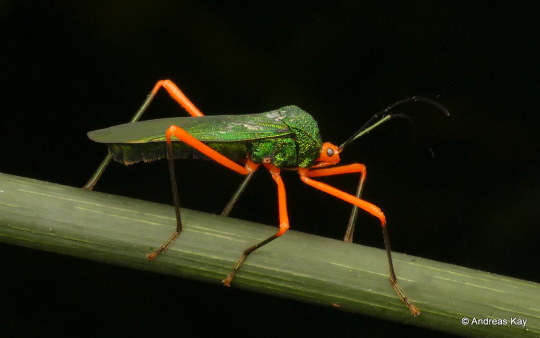Submissions of little babs & identification curiosities welcome!!!
Don't wanna be here? Send us removal request.
Photo

Unidentified woodlouse, Oniscidea
Photographed in Singapore by budak
767 notes
·
View notes
Text
Giant Malaysian Katydid is a species of carnivorous giant katydid. It is one of the largest insects in the world.This is its sound 😮
6K notes
·
View notes
Text

Shellac-backed Pixie (Tipulogaster glabrata), male, taken June 8, 2025, in Georgia, US
A fairly fragile-looking pixie robber fly perching on a grass shoot! I've been seeing these lovely lads flying around for the first time this spring. I've yet to see a female, which are surprisingly the ones with the bright coloration, having a bright red spot on their scutum and a redder tinge to their body. These guys are super hard to photograph, being smaller and faster than a damselfly and consequently extremely easy to lose once they start moving. Nevertheless, I'm always happy to see a new robber fly!
11 notes
·
View notes
Note

Big preggo lady accidentally ended up in the feed kitchen, so I had to run all the way to the other end of the zoo to get her home
An escaped criminal!! I love her
346 notes
·
View notes
Text


First batch of nymphs this year, rather late, but they don't seem like runts.
6 notes
·
View notes
Photo







Leaf-footed bugs in the genus Paryphes, Coreidae
Photographed in Ecuador by Andreas Kay
1K notes
·
View notes
Text


Bug of the Day
Always cool to see this little dude show up at the lights. Sparkly and orange!!
(Linnaeus's Spangle-wing, Chrysoclista linneella)
104 notes
·
View notes
Text


every flower-loving arthropod has to coexist with said flower's ever-omnipresent thrips at some point, but in the case of this little halictid bee it really looks like the Aeolothrips on the left is her purse dog that she shares a home with
(March 15th, 2025)
171 notes
·
View notes
Text










Lots of Megarhyssa spp. ovipositing on dying beech! M. atrata and M. macrurus or greenei. I always enjoy seeing these Ichneumonids! Ottawa, Ontario, Canada.
2K notes
·
View notes
Photo



Scorpion-tailed spider, Arachnura sp., Araneidae
Photographed in Singapore by budak
2K notes
·
View notes
Text



Early bumblebee/ängshumla, and Buff-tailed bumblebee/mörk jordhumla. Värmland, Sweden (June 3, 2022).
2K notes
·
View notes
Text

Have you ever seen a giant worm? 👀🪱 While there are thousands of earthworm species known across the planet, only a handful are supersized. Members of the genus Martiodrilus can grow up to an incredible 4.9 ft (1.5 m) in length and weigh up to 1.1 lbs (0.5 kg)! Inhabiting underground burrows in parts of South America such as Colombia and Ecuador, these worms are rarely seen above ground—but can sometimes be heard as they move through the soil.
Photo: OWP / oliverpatrick, CC BY-NC 4.0, iNaturalist
5K notes
·
View notes
Photo




Bicolored snakefly, Agulla bicolor, Raphidiidae
Found in western North America
Photo 1 by mason_s, 2 by tcouncil, and 3-4 by ecarpe
2K notes
·
View notes





